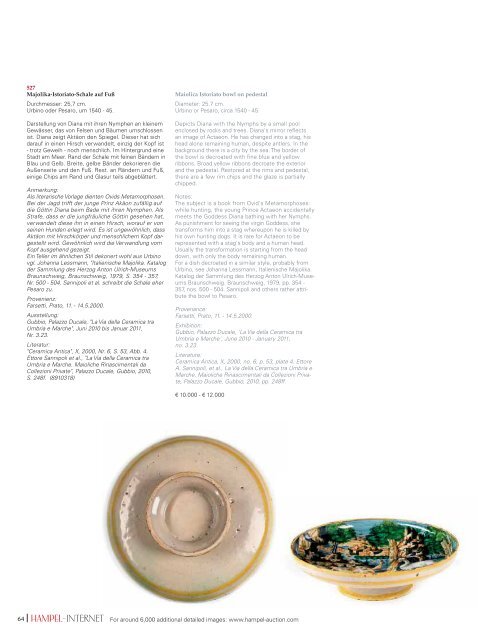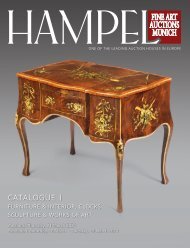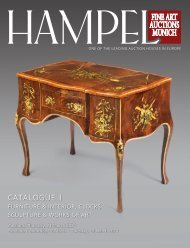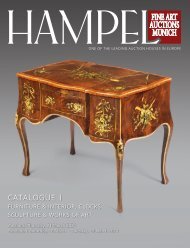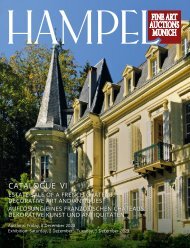Sammlung Majolika
- Keine Tags gefunden...
Erfolgreiche ePaper selbst erstellen
Machen Sie aus Ihren PDF Publikationen ein blätterbares Flipbook mit unserer einzigartigen Google optimierten e-Paper Software.
527<br />
<strong>Majolika</strong>-Istoriato-Schale auf Fuß<br />
Durchmesser: 25,7 cm.<br />
Urbino oder Pesaro, um 1540 - 45.<br />
Darstellung von Diana mit ihren Nymphen an kleinem<br />
Gewässer, das von Felsen und Bäumen umschlossen<br />
ist. Diana zeigt Aktäon den Spiegel. Dieser hat sich<br />
darauf in einen Hirsch verwandelt, einzig der Kopf ist<br />
- trotz Geweih - noch menschlich. Im Hintergrund eine<br />
Stadt am Meer. Rand der Schale mit feinen Bändern in<br />
Blau und Gelb. Breite, gelbe Bänder dekorieren die<br />
Außenseite und den Fuß. Rest. an Rändern und Fuß,<br />
einige Chips am Rand und Glasur teils abgeblättert.<br />
Anmerkung:<br />
Als literarische Vorlage dienten Ovids Metamorphosen.<br />
Bei der Jagd trifft der junge Prinz Akäon zufällig auf<br />
die Göttin Diana beim Bade mit ihren Nymphen. Als<br />
Strafe, dass er die jungfräuliche Göttin gesehen hat,<br />
verwandelt diese ihn in einen Hirsch, worauf er von<br />
seinen Hunden erlegt wird. Es ist ungewöhnlich, dass<br />
Aktäon mit Hirschkörper und menschlichem Kopf dargestellt<br />
wird. Gewöhnlich wird die Verwandlung vom<br />
Kopf ausgehend gezeigt.<br />
Ein Teller im ähnlichen Stil dekoriert wohl aus Urbino<br />
vgl. Johanna Lessmann, "Italienische <strong>Majolika</strong>. Katalog<br />
der <strong>Sammlung</strong> des Herzog Anton Ulrich-Museums<br />
Braunschweig, Braunschweig, 1979, S. 354 - 357,<br />
Nr. 500 - 504. Sannipoli et al. schreibt die Schale eher<br />
Pesaro zu.<br />
Provenienz:<br />
Farsetti, Prato, 11. - 14.5.2000.<br />
Ausstellung:<br />
Gubbio, Palazzo Ducale, "La Via della Ceramica tra<br />
Umbria e Marche", Juni 2010 bis Januar 2011,<br />
Nr. 3.23.<br />
Literatur:<br />
"Ceramica Antica", X, 2000, Nr. 6, S. 53, Abb. 4.<br />
Ettore Sannipoli et al., "La Via della Ceramica tra<br />
Umbria e Marche. Maioliche Rinascimentali da<br />
Collezioni Private", Palazzo Ducale, Gubbio, 2010,<br />
S. 248f. (8910318)<br />
Maiolica Istoriato bowl on pedestal<br />
Diameter: 25.7 cm.<br />
Urbino or Pesaro, circa 1540 - 45.<br />
Depicts Diana with the Nymphs by a small pool<br />
enclosed by rocks and trees. Diana's mirror reflects<br />
an image of Actaeon. He has changed into a stag, his<br />
head alone remaining human, despite antlers. In the<br />
background there is a city by the sea. The border of<br />
the bowl is decroated with fine blue and yellow<br />
ribbons. Broad yellow ribbons decroate the exterior<br />
and the pedestal. Restored at the rims and pedestal,<br />
there are a few rim chips and the glaze is partially<br />
chipped.<br />
Notes:<br />
The subject is a book from Ovid's Metamor phoses:<br />
while hunting, the young Prince Actaeon accidentally<br />
meets the Goddess Diana bathing with her Nymphs.<br />
As punishment for seeing the virgin Goddess, she<br />
transforms him into a stag where upon he is killed by<br />
his own hunting dogs. It is rare for Actaeon to be<br />
represented with a stag's body and a human head.<br />
Usually the transformation is starting from the head<br />
down, with only the body remaining human.<br />
For a dish decroated in a similar style, probably from<br />
Urbino, see Johanna Lessmann, Italienische <strong>Majolika</strong>.<br />
Katalog der <strong>Sammlung</strong> des Herzog Anton Ulrich-Muse -<br />
ums Braunschweig. Braunschweig, 1979, pp. 354 -<br />
357, nos. 500 - 504. Sannipoli and others rather attri -<br />
bute the bowl to Pesaro.<br />
Provenance:<br />
Farsetti, Prato, 11. - 14.5.2000.<br />
Exhibition:<br />
Gubbio, Palazzo Ducale, 'La Via della Ceramica tra<br />
Umbria e Marche', June 2010 - January 2011,<br />
no. 3.23.<br />
Literature:<br />
Ceramica Antica, X, 2000, no. 6, p. 53, plate 4. Ettore<br />
A. Sannipoli, et al., La Via della Ceramica tra Umbria e<br />
Marche. Maioliche Rinascimentali da Collezioni Priva -<br />
te, Palazzo Ducale, Gubbio, 2010, pp. 248ff.<br />
€ 10.000 - € 12.000<br />
64<br />
For around 6,000 additional detailed images: www.hampel-auction.com


